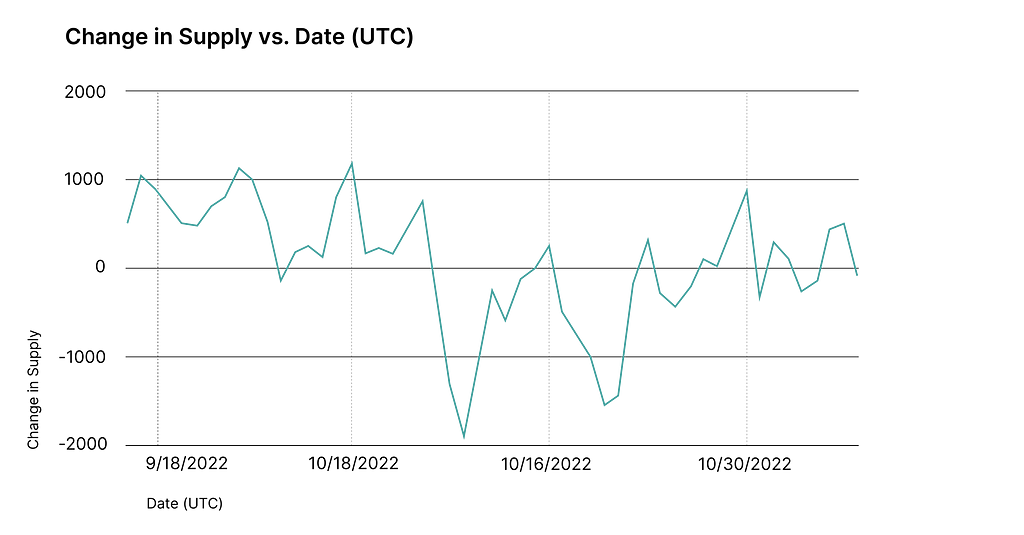Latest news about Bitcoin and all cryptocurrencies. Your daily crypto news habit.

Ethereum’s transition to proof-of-stake (PoS) was a historic moment in distributed engineering that reduced Ethereum’s carbon footprint by 99.99% with more than 41,000 people watching the final Merge block successfully transition the Ethereum blockchain. Perhaps the most notable characteristic of the event was just how un-eventful it was, in hindsight.
Immediately, with no issues or network disruptions, we knew there was no further risk of delays. Looking back, we can see a sharp increase in validators in just a five month period to today:
- May 15 — Sept 15 (Merge date): 287 ETH staked/day on average
- Sept 15 — present: 623 ETH staked/day on average
It appears that the sentiment is growing in favor of ETH staking once more. Now, a few months later, we have a material body of data to help us better understand what’s changed and why this matters to institutions and clients of Anchorage Digital.
More, New Rewards
The total reward rate for staking ETH currently ranges from 4.1% ~ 4.8% and is sourced as a result of block proposal rewards.
Validators receive block proposal rewards for successfully appending a new block to the chain. However, not all proposals are created equal — depending on “priority fees”, or ETH paid on top of gas fees to incentivize the block proposer to include the transaction in a block, rewards can be higher or lower. Anchorage Digital enables its clients to receive higher rewards than standard methods, with high security by both custodying clients’ staked ETH in separate accounts, and using optimal technology to receive rewards.
Priority fees are largely based on network use, where more activity correlates with higher rewards. Some staking providers are reporting total reward rates of greater than 10% in mid-November, which was a particularly volatile market period.
Staking providers often maximize priority fees by enabling a relay service such as Flashbots, which “bids” for a block containing a particular order of transactions to be accepted by the proposer, and Anchorage Digital handles this setup for its clients. The chart below shows the difference between fees earned by validators with Flashbots enabled and without.

From Flashbots’ Transparency Dashboard, showing the difference between blocks produced with and without the relay service. Additionally, at the time of writing, MEV analytics company Rated collects information from all relay services including Flashbots and found that relay rewards are nearly 3.8 times higher than standard block production without the use of Flashbots.
It’s important to note that penalties are also inherent in participation in ETH staking. proof-of-stake has two classes: uptime penalties and slashing. The former is related to slowness, such as a lag in network connectivity. The latter is for comparatively worse behavior, such as attesting to or proposing two different blocks for the same slot. Since the Beacon Chain’s inception, 218 validators have been slashed.
All the complexity around maximizing rewards and avoiding slashing underscores the importance of selecting a technology partner who can be trusted to operate a validator node well and honestly. Staking through Anchorage Digital gives clients access to Flashbots-enabled validators by default, as well as penalty insurance should the nodes malfunction and cause rewards to be lost.
Deflationary ETH
In proof-of-work, the entities who secure the network incur heavy capital expenditures in the form of mining equipment and energy needed to run the equipment. For incentives to mine to work effectively, the block rewards have to exceed the expenses necessary to keep the network secure. For the Ethereum blockchain, previously, this was 2 ETH per block. With proof-of-stake, those costs are nonexistent, so the block reward can be much lower.
As a result, the token burning mechanism introduced in EIP-1559 can cause the amount of ETH burned to outpace the amount minted. When this occurs, the network becomes deflationary.
Etherscan supplies this view of ETH supply in the days immediately following the Merge:

If ETH goes net deflationary, some see staking as an avenue to get a larger piece of a shrinking pie.
The Future
In the months immediately following the Merge, new reward types were enabled that allowed the network to go deflationary for the first time ever. It is expected that withdrawals will be enabled within a year, which should remove another commonly cited reason for hesitancy around staking.
As more entities join to help secure the network, rewards per validator will decrease. So while timing is a factor, having a strong staking partner is equally important in securely receiving rewards. Anchorage Digital offers the ability to stake natively from its industry-leading custody, complete with uptime guarantees to minimize concerns. To learn more about Anchorage Digital’s staking services, clients should contact their relationship manager and prospective clients can get in touch with us at anchoragesales@anchorage.com.
This post is intended for informational purposes only. It is not to be construed as and does not constitute an offer to sell or a solicitation of an offer to purchase any securities in Anchor Labs, Inc., or any of its subsidiaries, and should not be relied upon to make any investment decisions. Furthermore, nothing within this announcement is intended to provide tax, legal, or investment advice and its contents should not be construed as a recommendation to buy, sell, or hold any security or digital asset or to engage in any transaction therein.
Disclaimer
The views and opinions expressed in this article are solely those of the authors and do not reflect the views of Bitcoin Insider. Every investment and trading move involves risk - this is especially true for cryptocurrencies given their volatility. We strongly advise our readers to conduct their own research when making a decision.